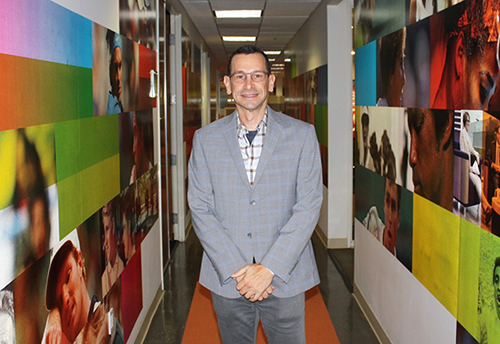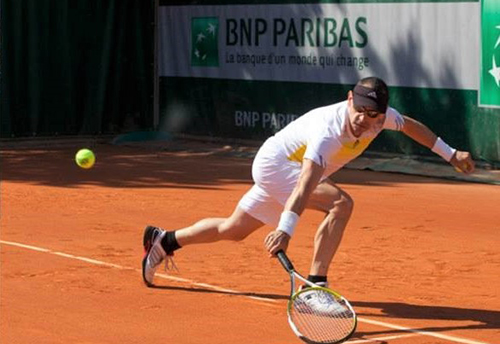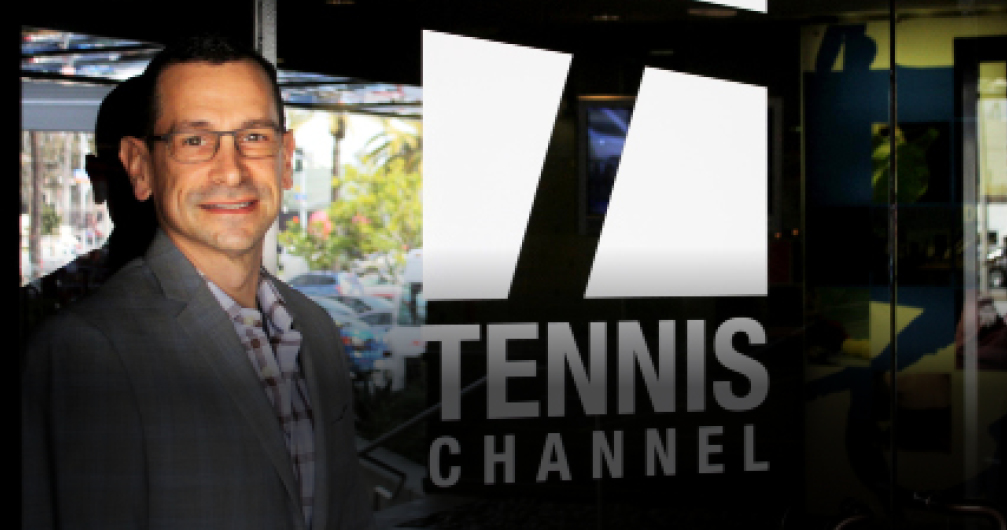When his cell phone rang, Peter Steckelman ’93 was in Paris, watching Roger Federer play from a third-row seat. Steckelman, who is Senior Vice President of Business and Legal Affairs for Tennis Channel, had come to Roland-Garros to negotiate a media rights issue concerning Tennis Channel’s French Open coverage.
As he took the call, friends who had joined him for the match saw his eyes widen. When Steckelman hung up, he told them he was headed to a different court. Tennis Channel’s production crew needed a stand-in to hit with Martina Navratilova, one of the best players of all time, for an on-air feature. That someone was him.
Fifteen minutes later, Steckelman found himself getting pushed behind the baseline by the sheer force of Navratilova’s shots, as he and the tennis legend warmed up for the feature shoot.
“She’s grooving and putting some stick on the ball, and we’re actually having some really good rallies,” he recalls. “About half the time, I forgot whom I was playing. The other half, my head was spinning. I didn’t want to screw it up, so I pushed through.”
After warming up, the duo shot the feature in two takes, and Steckelman even earned an unsolicited compliment from Navratilova.
Steckelman’s Keys to Success
 As head of a small, efficient in-house team at Tennis Channel, Steckelman brings a similarly cool head to his off-court duties. In any given moment, he might be called upon to negotiate and review a contract for on-air talent, deal with a rights issue, research risk assessment, or manage the legal implications of a crisis, like a power outage at a tournament site.
As head of a small, efficient in-house team at Tennis Channel, Steckelman brings a similarly cool head to his off-court duties. In any given moment, he might be called upon to negotiate and review a contract for on-air talent, deal with a rights issue, research risk assessment, or manage the legal implications of a crisis, like a power outage at a tournament site.
“You have to be nimble, flexible, and ready to be bombarded with questions you can answer on the spot,” he says. “You also have to be politically smart. It’s an art as much as a science, and you learn through experience.”
In his eight years at Tennis Channel, Steckelman is most proud of a period when he and his team took on a sudden breach-of-contract dispute that could have spelled trouble for the company. Though the dispute was never made public and was ultimately resolved in Tennis Channel’s favor, it consumed his job for more than a year.
“I led the effort with the help of our outside counsel, and over time it evolved from the shock of ‘Are you kidding me?’ to the validation that we were right all along,” he says. “I patted myself on the back and moved on to the next thing.”
When Steckelman arrived at Tennis Channel eight years ago, it had around 25 million subscribers. He’s had a front-row seat as that number has climbed to more than 60 million. To support the company’s growth, Steckelman has worked to build legal awareness into the culture.
Shortly after he joined Tennis Channel, an ad sales rep (no longer working for the company) pushed him to allow one of its smaller sponsors to use Roger Federer’s image in an ad. Though Steckelman explained that if he let the rep proceed, the company would be exposing itself to significant legal risk, the rep struggled to understand why. Today, the entire ad team is well-versed in rights and publicity issues and often brings Steckelman creative solutions they’ve already considered from a legal perspective.
“At this point, they only need light backstopping from me,” he says. “They can be more confident about copyright and publicity issues because they have a better understanding of the legalities and the business risk to the network. It’s been a shift in culture, and I’m very proud of that.”
From on Court to in Court
 Steckelman sees natural parallels between law and tennis. Like lawyering, tennis demands both proactive and reactive strategies when confronting an adversary. A player—or lawyer—arrives with a plan. But when the opponent makes a surprise move, problem-solving in the moment becomes key.
Steckelman sees natural parallels between law and tennis. Like lawyering, tennis demands both proactive and reactive strategies when confronting an adversary. A player—or lawyer—arrives with a plan. But when the opponent makes a surprise move, problem-solving in the moment becomes key.
“Litigating in front of a judge, handling a business negotiation, or playing a match—in all three, you have to come up with solutions in real time,” he says. “In tennis, the ball doesn’t care if you’re having a bad day. Similarly, the deal doesn’t care. The courtroom doesn’t care. If you have a problem, it’s up to you to get unstuck and stay focused on your main objective.”
For Steckelman, NYLS was the proving ground that first taught him these lessons. He recalls Associate Dean William LaPiana, Professor Nadine Strossen, and Professor Emerita Kim Lang as being particularly formative teachers who demanded the best of him.
“NYLS prepared me to be the kind of professional who can handle the things that come easy and who also knows when to roll up his sleeves,” he says. “I had high expectations going in, but NYLS had even higher ones.”


